14
Abandoned Mine Shaft, New Annan, Nova Scotia, Canada2 June 2010
New Annan, Nova Scotia, Canada
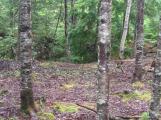 Credits:
Credits:Jim MacIntosh
15
This picture shows the collapsed mine shaft, a depression about 20 feet (6m) deep and 50 feet (15m) across.More and more copper mines were being discovered. In 1900, an Inspector of Mines investigated a copper mine along the French River, 5 miles (8.5km) from Tatamagouche Station, where considerable development was underway. Shafts were sunk to 100 feet (30m), and at the 80 feet (24m) mark, copper was found in the samples. There was a ladderway boxed and platformed every 10-15 feet (3m-4.5m) and a tub for men to travel in. There were shafts and tunnels with pumps to extract water, a 20 horse power engine for hoisting (although the hoist had no brake) and for working the Cornish pump, but the 50 horsepower boiler was considered unsafe. On the other side of the river, a 200 feet (60m) tunnel was dug into the bank in the search for more ore.
A road was constructed down the valley side to enable horses to haul the trams of ore away.
There were bunk houses, a cookhouse, stables, blacksmith shop, carpentry shops... in fact a large complex of buildings, none of which exist today. By 1900 the Copper Crown Company was searching for more ore deposits, but by 1901 they had suspended operations in New Annan. A considerable amount of work and expenditure, with very few people benefiting from it.
16
Support Posts for Lintel, Copper Mine, New Annan, Nova Scotia, Canada2 June 2010
New Annan, Nova Scotia, Canada
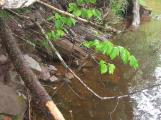 Credits:
Credits:Jim MacIntosh
17
In 1900, the American company Colonial Copper Company began operations on Patterson's site in New Annan. They appeared to have gained the rights to three square miles of land; in fact they had 56 acres (22.4 hectares) lying across the French River at the Patterson site in Oliver.A shaft was sunk 300ft (90m). New machinery replaced old. A small trestle bridge and tramway were constructed across the river, where a vertical shaft was sunk. They encountered a layer of heavy rock containing iron in the shaft so had to bring in a diamond drill. The company hosted viewings so that the public could see the excavations for new seams of ore and perhaps buy shares in the property. It turned out that the whole thing was a scheme for American stockholders, many of whom made money, but many more did not. Despite this, later someone actually did purchase the site.
The west bank has collapsed and the shafts have been filled and covered.
18
Lintel of Collapsed Lateral Shaft, New Annan, Nova Scotia, Canada2 June 2010
New Annan, Nova Scotia, Canada
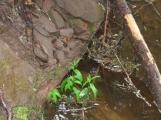 Credits:
Credits:Jim MacIntosh
19
Copper was found at the beginning of the 20th Century on Black Brook (another one!), a branch of McLeod's brook. The samples obtained were promising but no further development occured.20
Forbes Place, New Annan, Nova Scotia, Canada2 June 2010
New Annan, Nova Scotia, Canada
 Credits:
Credits:Jim MacIntosh
21
Other copper mine sites were discovered after this, in the Waughs River area, but the ore ran out quickly, or proper legal steps for extraction of ore were not taken. Little more was done in the copper industry until the middle of the 20th Century.22
Gold: Gold Mine Shaft, New Annan, Nova Scotia, Canada28 June 2010
New Annan, Nova Scotia, Canada
 Credits:
Credits:R.Campbell
23
Gold MiningIn February 1893, a newspaper account gave the first indication of gold within the area of New Annan. Until then, according to the account, Robert Bass of Block House, Tatamagouche, had found gold but did not accept an offer of $20 000 for his gold mine property. Copper was in fact found there, but it was not mined unless on a very small scale.
The search for gold bearing rock had been fairly extensive and reports that samples of the quartz taken from the area were very promising,encouraged the Gilt Edge Gold Mining Company in 1902/3 to start plans for developing its holdings in New Annan. Some 20 men worked there,clearing the site and undertaking the construction of a road.The owners of the property leased the mine to the company for a number of years, eventually receiving $100 each day.
24
Goldmine Brook, New Annan, Nova Scotia, Canada28 June 2010
New Annan, Nova Scotia, Canada
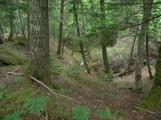 Credits:
Credits:R. Campbell
25
A lot of building and excavation work had been done on a small brook flowing from the west into Byers Brook. Since then this brook has been called Gold Mine Brook. As recently as 1984 there was still evidence of these explorations including a possible shaft or collapsed tunnel 10ft (3m) wide and 8ft (2.4m) deep. Now, in 2010, the area is very overgrown and it is hard to imagine the frenzied working that went on 100 years earlier.26
Gilt Edge Mining Co. New Annan, Nova Scotia, CanadaEarly 1900's
New Annan, Nova Scotia, Canada
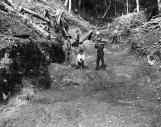 Credits:
Credits:North Shore Archives CSHC
27
A short distance downstream from Gold Mine Brook is another brook, called Miller Brook, (Katie's Brook or Little Brook;the latter name appeared in the mining agreement with the land owner). Mining buildings were erected, such as a cookhouse and bunkhouse.In September 1903, the Truro Daily News printed a mining update: "The Gilt Edge Mining Co., with a capital of $1 million, is making good progress with the preparations for the development of its gold area in West New Annan. The Company's building for their stamp mill and other machinery is 140ft (42m) long by 24ft (7.2m) wide and 2 stories high. The machinery, which comes from New York, will soon be installed, and operations for the plant will commence in November." It all sounded very promising.